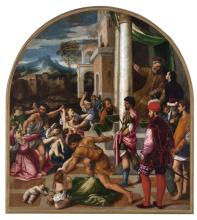The painting comes from the Hall of the Council of Ten in the Palazzo dei Camerlenghi at Rialto and was probably executed in about 1537, as seems to be documented in a payment of ten scudi dated 31 January, which some scholars interpret as relating to the painting. Through deft promotional manoeuvering, Bonifacio Veronese managed to obtain a monopoly on decorating the new palazzo (which was rebuilt after being gutted by fire in 1514), working on the building along with a large group of collaborators for thirty years until his death in 1553. Stylistically, this Massacre of the Innocents betrays the plurality of models Veronese made reference to in these thirty years and, in compositional terms, is directly derived from Raphael, who was well known in Venice thanks to Marcantonio Raimondi’s printing presses. The brilliant colours playing on tonalities of bright red are particularly striking, such as in the figure in the foreground, which was liberally inspired by examples from Titian’s portraits. Even in his novel approach to the landscape element in the background, we can note a bent for the latest examples of reform in Venetian art and in particular the Giorgionesque “revolution”.
- Visit
- What's on
- On-line collections
- SEATS
- Exhibitions
- EDUCATION PROGRAMMES
- Online Activities
- Artworks not on display
- SPACES AND IMAGES CONCESSIONS
- SUPPORT US
-
TRANSPARENT ADMINISTRATION
- GENERAL PROVISIONS
- ORGANISATION
- CONSULTANTS AND COLLABORATORS
- STAFF
- PERFORMANCE
- Bandi e gare
- CONTRACTS
- Determine
- PROVVEDIMENTI
- BALANCE SHEETS
- GRANTS, CONTRIBUTIONS, SUBSIDIES, ECONOMIC ADVANTAGES
- ADMINISTRATIVE PAYMENTS
- LEGAL PROCEDURES
- ADMINISTRATIVE SUPERVISION AND EVALUATION
- ACCESSO CIVICO
- SERVICES PROVIDED
- OTHER CONTENTS
- CREDITS
- CONTACT
- English
- italiano
